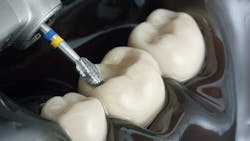Pearls for Your Practice: Q-Finishers by Komet USA
I was recently talking to my personal trainer about the pitfalls people fall into when trying to lose weight. “We all know that it comes down to diet and exercise. The problem is most people overexercise and underdiet,” he said. I pondered this for a second and immediately thought of my friends at CrossFit who routinely go for drinks after their weekend workouts.
In dentistry, I think the equivalent is how we handle the last parts of our resin composite procedures. I think most of us underfinish and overpolish. Q-Finishers by Komet USA can help with this!
More Pearls:
MI Paste One Perio by GC America
Practice Intelligence by Pearl AI
Q-Finishers are finishing burs that combine steps of finishing so we save steps, costs, and time, all while getting a better surface texture for our resin composite restorations. Most finishing burs are fluted carbide burs. The number of flutes varies with the level of finishing desired. 12-fluted finishing burs are good for initial finishing; 20-fluted finishing burs are good for a fine finish. Finally, a 30-fluted ultrafine finishing bur is great for that final finishing and texturing before polishing.
Unlike these standard fluted carbide finishing burs, Q-Finishers are cross-cut burs. Generally, cross-cut burs are designed to cut tooth and not finish, but because of the fine machine work done at Komet, the cross-cut toothing is very effective at finishing without being too aggressive.
This allows us to skip a couple of steps of finishing and finish most restorations with a single Q-Finisher bur. If you’re looking to go the extra mile, you may still want to use an ultrafine 30-fluted bur after the Q-Finisher. But even then, you’ve gotten to skip the standard and fine finishing steps.Q-Finishers should be used at 45,000 RPM. For a more aggressive finish, simply press harder on the restoration. For a finer finish, just lighten that pressure. No more switching burs in between.
Q-Finishers come in a variety of shapes and sizes. My go-to is the H134Q, which is flame-shaped, and the H379Q, which is football-shaped. One thing I really like about the H134Q is that the end is noncutting, so it’s safe to use around gingiva without creating tissue irritation.
For posterior restorations, I’ll generally just use one Q-Finisher to finish and adjust occlusion. I will do a quick polish with a single-step composite polishing system. For anterior restorations, I will use a Q-Finisher to finish and adjust occlusion. I will then do a quick ultrafine finish with a 30-fluted finishing bur and then some light polishing with either disks or points.
For posteriors, Q-Finishers help me skip a few steps and get done faster. For anteriors, Q-Finishers help me get a better finish so I can polish less and get a better result.
Editor's note: This article appeared in the June 2023 print edition of Dental Economics magazine. Dentists in North America are eligible for a complimentary print subscription. Sign up here.
About the Author
Joshua Austin, DDS, MAGD
Joshua Austin, DDS, MAGD, is a graduate and former faculty member of the University of Texas Health Science Center at San Antonio School of Dentistry. Author of Dental Economics’ Pearls for Your Practice column, Dr. Austin lectures nationally on products, dental technology, online reputation management, and social media. He maintains a full-time restorative dentistry private practice in San Antonio, Texas. You may contact Dr. Austin at [email protected].
Updated June 21, 2023

